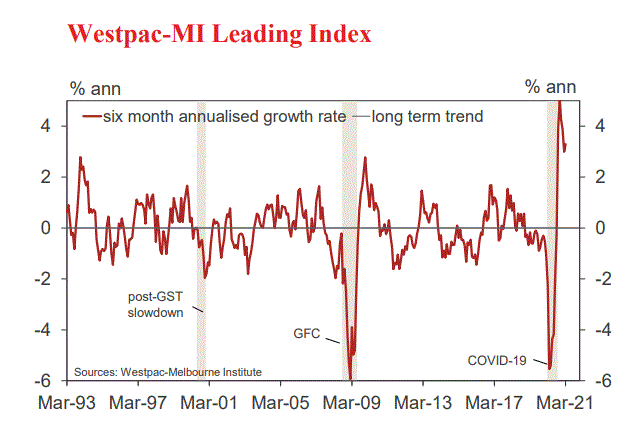Westpac with the note:

The growth rate of the Leading Index continues to point to above trend growth in 2021. Westpac is forecasting growth of 4.5% in 2021 largely driven by the consumer who is expected to contribute three of those percentage points.
The reopening of the economy; cashed up households; and an eleven year high in Consumer Sentiment all point to strong spending.
The housing market is booming. Westpac expects dwelling price growth of 15% in 2021 along with surging dwelling construction.
The Treasurer announces the Federal Budget on May 11. The Budget is unlikely to focus on fiscal repair. Despite recent encouraging progress, the unemployment rate is too high and well above the full employment level which is likely to be below 4%.
Budget initiatives should focus on further support for the economy as the government takes advantage of a substantial windfall improvement in the expected deficit in 2020/21.
Over the last six months the Index growth rate has lifted from –0.24% in September to 3.29% in March. The main components driving the 3.53ppt turnaround have been: total hours worked (contributing +1.88ppts), commodity prices, measured in AUD terms (+1.04ppts), US industrial production (+0.88ppts) and dwelling approvals (+0.66ppts) – all of which have switched from being negative drags on growth to strong supports. These improvements have been partially offset by reduced support from sentiment-based measures – despite a strong April read on confidence, moderating improvements over the last six months have seen smaller contributions from the Westpac-Melbourne Institute Consumer Expectations Index and the Westpac-Melbourne Institute Unemployment Expectations Index (taking 1.07ppts and off the headline growth rate on a combined basis). Other positive contributions from the ASX200 and the yield spread were unchanged”.
The Reserve Bank Board next meets on May 4 – one week before the Federal Budget.
We expect the Board to maintain current policy settings.
It is also likely to confirm that there is no immediate intention to intervene in the housing market using the macro-prudential-style measures seen in 2015 and 2017. Westpac expects that approach to change in 2022 as the authorities respond to further increases in prices and a likely lift in investor activity – in line with the signals from our Consumer Sentiment survey.
There will be considerable interest in the Bank’s revised detailed economic forecasts in the May Statement on Monetary Policy, which will be released on May 7.
Markets will focus on the revised forecast for the path of the unemployment rate following the fall in the unemployment rate from 6.3% to 5.6% over February and March. Accordingly, there is likely to be a significant downward revision to the forecast unemployment path.
The Bank also appears to have lowered its estimates of the full employment rate.
The net effect will be consistent policy guidance that it will still be some time – 2024 at the earliest – before the Bank expects to achieve its full employment and inflation targets. The faster likely improvement in the labour market will be offset by the more challenging target for the full employment rate.

